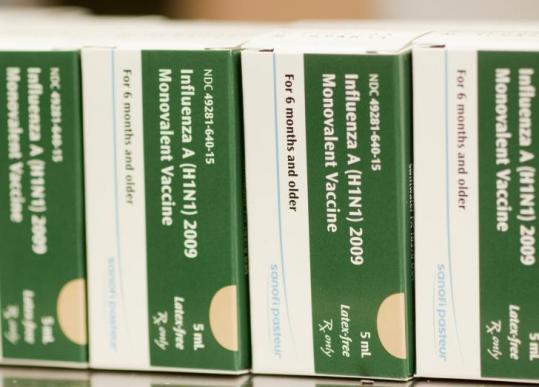skip to main |
skip to sidebar
Wide availability expected in mid-Nov. Those at high risk get vaccine earlier
 Vials of the vaccine for H1N1 were packaged before they were shipped at a plant in Swiftwater, Pa. Massachusetts is expected to receive 1.1 million doses by early November. (Sanofi-Aventis)
Vials of the vaccine for H1N1 were packaged before they were shipped at a plant in Swiftwater, Pa. Massachusetts is expected to receive 1.1 million doses by early November. (Sanofi-Aventis)
WORCESTER - Vaccine against swine flu will not be widely available in Massachusetts until mid-November, the state’s public health commissioner warned yesterday, even as specialists fear that cases of the viral disease will increase markedly in coming weeks.
Discuss
COMMENTS (74)
The Department of Public Health expects the first vaccine doses to arrive in the state no later than Oct. 12, but that initial shipment is expected to include only about half as many doses as originally anticipated.
Underscoring the fluid nature of the response to the H1N1 virus, state health authorities left their offices Tuesday night believing the shipment would contain 63,500 doses; by midday yesterday, it had been cut to 36,800.
The state now expects to receive 1.1 million doses by early November and 700,000 more by early December. Still, that is not even half of the 4 million vaccine shots and nasal sprays designated for Massachusetts by the federal government, which is buying all of the nation’s vaccine supply.
“For the public, it’s important to know not to expect the large public [flu shot] clinics until middle to late November,’’ John Auerbach, the public health commissioner, said in an interview during a statewide conference on swine flu that attracted more than 800 health, education, and public safety officials.
In the first weeks of the swine flu vaccination campaign, health care workers and groups most vulnerable to the virus will be targeted for doses. That includes pregnant women; children between 6 months and 4 years; people who have regular contact with young infants; and youngsters between 5 and 19 diagnosed with chronic conditions such as asthma, heart disease, and diabetes. Those groups are estimated to total 840,000 people. After they are inoculated through their physicians’ offices, vaccine will begin to be more broadly distributed.
Some disease specialists, including a presidential advisory panel, have expressed concerns that most H1N1 vaccine will not become available until after a second wave of infections peaks.
“While it would be preferable to have vaccine in early October, there will still be benefits to getting it in mid-November,’’ said Dr. JudyAnn Bigby, the state’s secretary of health and human services. “We still don’t know how this virus is going to behave.’’
The uncertainty about when vaccine shipments will arrive reflects the vagaries of flu vaccine production, as well as the unprecedented attempt this fall to deliver nearly 200 million doses of protection against swine flu and 115 million doses aimed at the seasonal strain.
Flu vaccine makers rely on an antiquated, time-consuming process to produce shots, growing the medicine in eggs. With the identification of swine flu in late April, scientists began a sprint to brew the right vaccine and begin processing it.
The same pharmaceutical companies are making both types of vaccine, and spot shortages of the seasonal variety have already emerged.Continued...
 Vials of the vaccine for H1N1 were packaged before they were shipped at a plant in Swiftwater, Pa. Massachusetts is expected to receive 1.1 million doses by early November. (Sanofi-Aventis)
Vials of the vaccine for H1N1 were packaged before they were shipped at a plant in Swiftwater, Pa. Massachusetts is expected to receive 1.1 million doses by early November. (Sanofi-Aventis)  Vials of the vaccine for H1N1 were packaged before they were shipped at a plant in Swiftwater, Pa. Massachusetts is expected to receive 1.1 million doses by early November. (Sanofi-Aventis)
Vials of the vaccine for H1N1 were packaged before they were shipped at a plant in Swiftwater, Pa. Massachusetts is expected to receive 1.1 million doses by early November. (Sanofi-Aventis) 

No comments:
Post a Comment